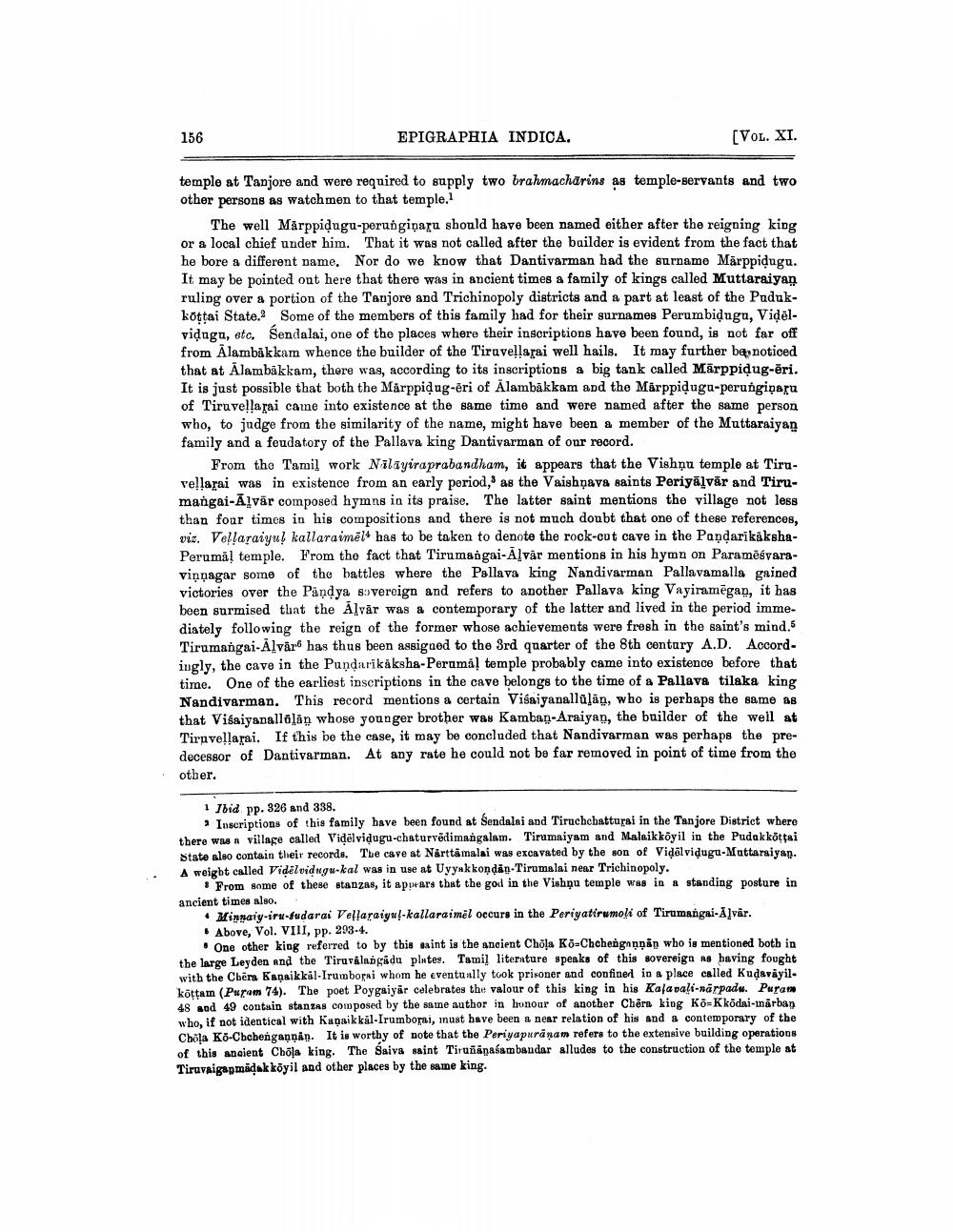________________
156
EPIGRAPHIA INDICA.
(VOL. XI.
temple at Tanjore and were required to supply two brahmacharins as temple-servants and two other persons as watchmen to that temple.
The well Mårppidugu-perungiņafu should have been named either after the reigning king or a local chief under him. That it was not called after the builder is evident from the fact that he bore a different name. Nor do we know that Dantivarman had the surname Märppidugu. It may be pointed out here that there was in ancient times a family of kings called Muttaraiyan ruling over a portion of the Tanjore and Trichinopoly districts and a part at least of the Padukkottai State. Some of the members of this family had for their surnames Perumbiduga, Vidēlviduga, etc. Sendalai, one of the places where their inscriptions have been found, is not far off from Ālambakkam whence the builder of the Tiruvellarai well hails. It may further be noticed that at Alambakkam, there was, according to its inscriptions a big tank called Mārppidug-ēri. It is just possible that both the Märppidug-ēri of Alambakkam and the Märppiduga-perungipasu of Tiruvellarai came into existence at the same time and were named after the same person who, to judge from the similarity of the name, might have been a member of the Muttaraiyan family and a feudatory of the Pallava king Dantivarman of our record.
From the Tamil work Nilayiraprabandham, it appears that the Vishņu temple at Tiruvellarai was in existence from an early period, as the Vaishnavs saints Periyālvār and Tirumangai-Ā!vār composed hymns in its praise. The latter saint mentions the village not less than four times in his compositions and there is not much doubt that one of these references, viz. Vellaraiyul kallara imēli has to be taken to denote the rock-cut cave in the PandarikákshaPerumal temple. From the fact that Tirumangai-Alvár mentions in his hymn on Paramēśvaraviņnagar some of the battles where the Pallava king Nandivarman Pallavamalls gained victories over the Påndya s:vereign and refers to another Pallava king Vayiramēgan, it has been surmised that the Alvar was a contemporary of the latter and lived in the period immediately following the reign of the former whose achievements were fresh in the saint's mind.5 Tirumangai-Alvårt has thus been assigned to the 3rd quarter of the 8th century A.D. Accordingly, the cave in the Pundarikáksha-Perumal temple probably came into existence before that time. One of the earliest inscriptions in the cave belongs to the time of a Pallava tilaka king Nandivarman. This record mentions a certain Visaiyanallalan, who is perhaps the same as that Visaiyanallőlan whose younger brother was Kamban-Araiyan, the builder of the weil at Tiruvellarai. If this be the case, it may be concluded that Nandivarman was perhaps the predecessor of Dantivarman. At any rate he could not be far removed in point of time from the other.
1 lbid pp. 326 and 338.
Inscriptions of this family bave been found at Sendalai and Tiruchchatturai in the Tanjore District where there was a village called Videlvidugu-chaturvēdimangalam. Tirumaiyam and Malaikköyil in the Pudakkottai State also contain their records. The cave at Nárttamalai was excavated by the son of Vidolvidugu-Muttarsiyan. A weight called Videloidugu-kal was in use at Uyyakkondan-Tirumalai near Trichinopoly.
From some of these stanzas, it appears that the god in the Vishņu temple was in a standing posture in ancient times also.
• Minnaiy-iru-fudarai Vellaraiyul-kallaraimēl occurs in the Periyatirumoli of Tirumangai-Alvar.
Above, Vol. VIII, pp. 293-4.
• One other king referred to by this wint is the ancient Chöļa Ko-Chehengonpin who is mentioned both in the large Leyden and the Tiruvalangadu plates. Tamil literature speaks of this sovereign na baving fought with the Cbēra Kanaikkal Irumborni whom he eventually took prisoner and confined in a place called Kudaviyil. köttam (Purum 74). The poet Poygaiyar celebrates the valour of this king in his Kalavalinärpadu. Puran 48 and 49 contain stanzas composed by the same author in honour of another Chóra king Ko-Kködni-inārban who, if not identical with Kapaikkal-Irumborai, inust have been a near relation of his and a contemporary of the Chola Ko-Chebengannan. It is worthy of note that the Periyapuranam refers to the extensive building operations of this ancient Chola king. The Saiva saint Tirunānasambandar alludes to the construction of the temple at Tiruvaigapmidak köyil and other places by the same king.




